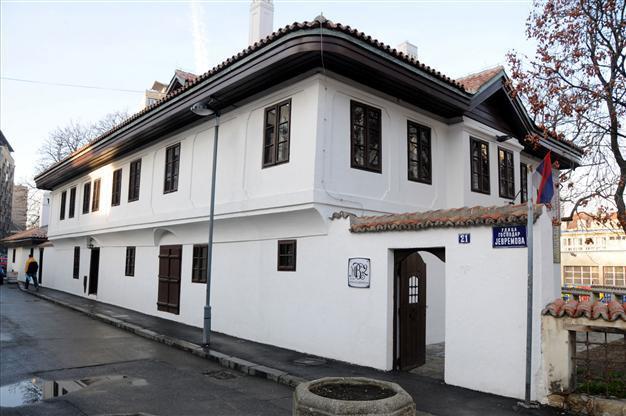Serbian heroes honored in Ottoman house-museum
BELGRADE - Anatolia News Agency

Belgrade’s Ottoman-era house, which
turned into a museum, displays belongings
of Serbian poet Dositej Dimitrije Obradovic and linguist Vuk StefanovicKaradzic. AA Photo
Cultural authorities in Belgrade have chosen an Ottoman-era structure to house a new museum dedicated to preserving Serbia’s history through its commemoration of two figures key in the development of modern Serbian culture.
“I am not sure that if these men saw Serbia they would remember the country as it was in history. We wanted to keep [the house] as it was, and I will do my best,” Serbian President Tomislav Nikolic said at the recent opening of the museum, which will contain the belongings of linguist Vuk Stefanovic Karadzic (1787-1864) and poet Dositej Dimitrije Obradovic (1742-1811).
Belgrade features many Ottoman buildings as a legacy of 350 years of imperial rule that had once bequeathed 273 mosques. While many of the Muslim houses of worship were demolished after the Turks left, many of the old Turkish neighborhoods retain their Turkish names.
“In this building, the first university of Serbia was opened and with it, the creation of a more European Serbia began,” the president said at the opening o the Dositej and Vuk Museum, which stands on one of Belgrade’s busier streets, Jevremova Avenue, while noting that Obradovic was a very important philosopher in Serbian history.
Museum of philosopher and poetObradovic was a Serbian author, philosopher, linguist, traveler, polyglot and the first minister of education of Serbia. An influential protagonist in the Serbian national and cultural renaissance, he advocated Enlightenment and rationalist ideas while remaining a Serbian patriot and an adherent of the Serbian Orthodox Church. Widely regarded as the founder of modern Serbian literature, he is commonly referred to by his first name alone. He became a monk in the Serbian Orthodox monastery of Hopovo, in the Srem region, and acquired the name Dositej (Dositheus). He translated many European classics, including Aesop’s Fables, into Serbian.
Obradovic’s most substantial contribution to the education of his people lay in his dedicated use of the Serbian popular language. In his lifetime, the Serbs were divided into three linguistic camps: the educated few who spoke and wrote in Russian Church Slavonic (a language of prestige), other educated people who spoke and wrote in slavenoserbski (a hybrid of Russian Church Slavonic, Old Church Slavonic, Russian and local Serbian vernacular), and the masses, mostly illiterate, who spoke the local Serbian vernacular. As the Dictionary of Literary Biography explains, “Dositej considered the introduction of vernacular elements into the literary idiom necessary because he believed that only one in 10,000 people understood slavenoserbski well, whereas the language of the people was understood by all, peasants and educated people alike. With minor dialectal differences, the spoken language was the same in all the areas populated by the Serbs. If books were printed in the language of the people, they would reach broad segments of [the] population.”
Karadzic, on the other hand, was a Serbian philologist and linguist who was a major reformer of the Serbian language that is widely seen as the father of the study of Serbian folklore for his dedication to collecting songs, fairy tales and riddles. He was also the author of the first Serbian dictionary.
He was well known abroad and familiar to Jacob Grimm, Johann Wolfgang von Goethe and historian Leopold von Ranke. Karadzic was the primary source for von Ranke’s “Serbische Revolution” (Serbian Revolution), written in 1829.
In addition to Nikolic, the opening also drew Culture Minister Bratislav Petkovic and representatives of Serbia’s Muslim organizations.
No traces of Ottomans traces
Belgrade means “White city,” in Serbian. While up to 273 mosques were built in the city during the Ottoman era, only one, Bayraklı Mosque, has survived to the present day.
Belgrade was conquered by Sultan Süleyman the Magnificent in 1521.
The Turks greatly developed Belgrade in the 16th and 17th centuries, but lost the city following the Treaty of Passarowitz in 1718, after which it became part of the Hapsburg Empire, during whose reign many of the mosques were demolished.
The city changed hands until Serbia gained full independence in the 19th century.

